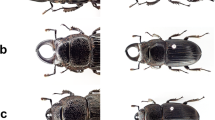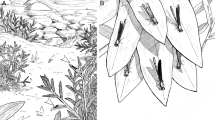Abstract
Intra-sexual dimorphism is found in the weapons of many male beetles. Different behavioral tactics to access females between major and minor males, which adopt fighting and alternative tactics, respectively, are thought to maintain the male dimorphism. In these species major males have enlarged weapons that they use in fights with rival males. Minor males also have small weapons in some of these species, and it is unclear why these males possess weapons. We examined the hypothesis that minor males might adopt a fighting tactic when their status was relatively high in comparison with that of other males (e.g., ownership of a territory). We observed the behavioral tactics of major and minor males of the beetle Librodor japonicus, whose males have a dimorphism of their mandibles. Major males fought for resources, whereas minor males adopted two status-dependent tactics, fighting and sneaking, to access females, depending on their ownership of a sap site. We suggest that ownership status-dependent mating tactics in minor males may maintain the intra-sexual dimorphism in this beetle.

Similar content being viewed by others
References
Andersson M (1994) Sexual selection. Princeton University Press, Princeton
Bridge AP, Elwood RW, Dick JTA (2000) Imperfect assessment and limited information preclude optimal strategies in male–male fights in the orb-weaving spider Metellina mengei. Proc R Soc Lond B Biol Sci 267:273–279
Davies NB (1978) Territorial defence in the speckled wood butterfly (Pararge aegeria): the resident always wins. Anim Behav 26:138–147
Eberhard WG (1979) The function of horns in Podischnus agenor (Dynastinae) and other beetles. In: Blum MS, Blum NA (eds) Sexual and reproductive competition in insects. Academic, New York, pp 231–258
Eberhard WG (1980) Horned beetle. Sci Am 242:124–131
Eberhard WG (1982) Beetle horn dimorphism: making the best of bad lot. Am Nat 119:420–426
Eberhard WG, Gutierrez EE (1991) Male dimorphisms in beetles and earwigs and question of developmental constraints. Evolution 45:18–28
Eberhard WG, Garcia-C JM (2000) Ritual jousting by horned Parisoschoenus expositus weevils (Coleoptera, Curculionidae, Baridinae). Psyche 103:55–84
Eberhard WG, Garcia-C JM, Lobo J (2000) Size-specific defensive structures in a horned weevil confirm a classic battle plan: avoid fights with larger opponents. Proc R Soc Lond B Biol Sci 267:1129–1134
Emlen DJ (1997) Alternative reproductive tactics and male dimorphism in the horned beetle Onthophagus acuminatus (Coleoptera: Scarabaeidae). Behav Ecol Sociobiol 41:335–341
Emlen DJ, Nijhout HF (2000) The development and evolution of exaggerated morphologies in insects. Annu Rev Entomol 45:661–708
Enquist M, Leimar O (1987) Evolution of fighting behavior: the effect of variation in resource value. J Theor Biol 127:187–205
Goldsmith SK (1985) Male dimorphism in Dendrobias mandibularis Audinet-Serville (Coleoptera: Cerambycidae). J Kans Entomol Soc 58:534–538
Gross MR (1996) Alternative reproductive strategies and tactics: diversity within sexes. Trends Ecol Evol 11:92–98
Hanley RS (2001) Mandibular allometry and male dimorphism in a group of obligately mycophagous beetles (Insecta: Coleoptera: Staphylinidae: Oxyporinae). Biol J Linn Soc 72:451–459
Hongo Y (2003) Appraising behaviour during male–male interaction in the Japanese horned beetle Trypoxylus dichotomus septentrionalis (Kono). Behaviour 140:501–517
Hongo Y (2006) Bark-carving behavior of the Japanese horned beetle Trypoxylus dichotomus septentrionalis (Coleoptera: Scarabaeidae). J Ethol 24:201–204
Hunt J, Simmons LW (2001) Status-dependent selection in the dimorphic beetle Onthophagus taurus. Proc R Soc Lond B Biol Sci 268:2409–2414
Jackson RR, Cooper KJ (1991) The influence of body size and prior residency on the outcome of male–male interactions of Marpissa marina, a New Zealand jumping spider (Araneae: Salticidae). Ethol Ecol Evol 3:79–82
Knell RJ, Pomfret CJ, Tomkins JL (2004) The limits of elaboration: curved allometries reveal the constraints on mandible size in stag beetles. Proc R Soc Lond B Biol Sci 271:523–528
Kotiaho JS, Tomkins JL (2001) The discrimination of alternative male morphologies. Behav Ecol 12:553–557
Miller KB, Wheeler QD (2005) Asymmetrical male mandibular horns and mating behavior in Agathidium Panzer (Coleoptera: Leiodidae). J Nat Hist 39:779–792
Moczek AP, Emlen DJ (2000) Male horn dimorphism in the scarab beetle, Onthophagus taurus: do alternative reproductive tactics favour alternative phenotypes? Anim Behav 59:459–466
Okada K, Miyatake T (2004) Sexual dimorphism in mandibles and male aggressive behavior in the presence and absence of female in the beetle Librodor japonicus (Coleoptera: Nitidulidae). Ann Entomol Soc Am 97:1342–1346
Pomfret JC, Knell RJ (2006) Sexual selection and horn allometry in the dung beetle Euoniticellus intermedius. Anim Behav 71:567–576
Rice WR (1989) Analyzing tables of statistical tests. Evolution 43:223–225
Rasmussen JL (1994) The influence of horn and body size on the reproductive behavior of the horned rainbow scarab beetle Phanaeus difformis (Coleoptera: Scarabaeidae). J Insect Behav 7:67–82
SAS Institute (1998) StatView 5.0 J. SAS Institute Inc, Cary
Simmons LW, Tomkins JH, Hunt J (1999) Sperm competition games played by dimorphic male beetles. Proc R Soc Lond B Biol Sci 266:145–150
Shuster SM, Wade MJ (2003) Mating system and strategies. Princeton University Press, Princeton
Siva-Jothy MT (1987) Mate securing tactics and the cost of fighting in the Japanese horned beetle, Allomyrina dichotoma L. (Coleoptera Scarabaeidae). J Ethol 5:165–172
Thornhill R, Alcock J (1983) The evolution of insect mating systems. Harvard University Press, Cambridge
Tomkins JL, Kotiaho JS, LeBas NR (2005) Matters of scale: positive allometry and the evolution of male dimorphisms. Am Nat 165:389–402
Acknowledgments
We thank D.J. Emlen for valuable comments on the manuscript.
Author information
Authors and Affiliations
Corresponding author
About this article
Cite this article
Okada, K., Miyatake, T. Ownership-dependent mating tactics of minor males of the beetle Librodor japonicus (Nitidulidae) with intra-sexual dimorphism of mandibles . J Ethol 25, 255–261 (2007). https://doi.org/10.1007/s10164-006-0021-0
Received:
Accepted:
Published:
Issue Date:
DOI: https://doi.org/10.1007/s10164-006-0021-0




